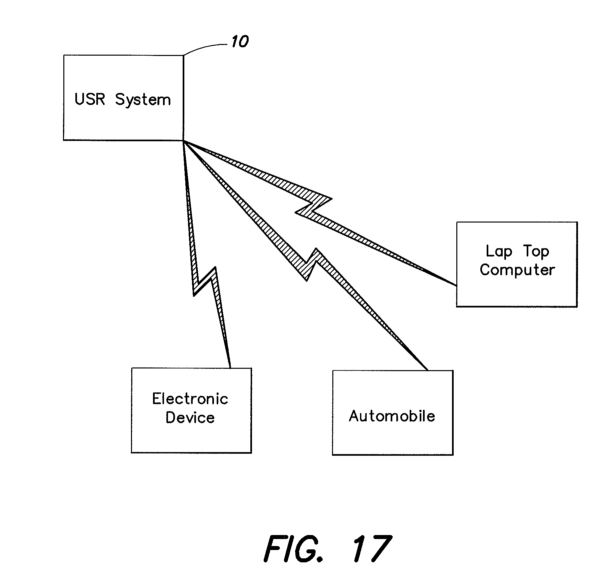by Dennis Crouch
The Alice test officially includes two steps. But these are highly correlated steps. Thus, if a claim fails step one, it usually fails step two as well. In this case, the court appears to borrow heavily from typical step two analysis in order to make its step one conclusion:
Universal Secure Registry v. Apple and Visa (Fed. Cir. 2021)
The district court dismissed USR’s patent infringement complaint, holding of all four asserted patents were ineligible under the abstract idea test incorporated into 35 U.S.C. § 101. On appeal, the Federal Circuit has affirmed. U.S. Patent Nos. 8,856,539; 8,577,813; 9,100,826; and 9,530,137.
The patents here are directed to technology for securing electronic payment transactions. This is an area of technology that the Federal Circuit has previously addressed. Here, the court notes that cases “often turn[] on whether the claims provide sufficient specificity to constitute an improvement to computer functionality itself.” Slip Op. Note that this statement from the court has two specific requirements: (1) that the claims be drafted with specificity; and (2) that the element claimed by an “improvement to computer functionality.” Generic claims are not enough; neither are specific claim limitations directed toward elements already well known in the art.
- Secured Mail Solutions LLC v. Universal Wilde, Inc., 873 F.3d 905 (Fed. Cir. 2017) (use of conventional generically claimed barcode to communicate information about the object being mailed was an abstract idea).
- Electronic Communication Technologies, LLC v. ShoppersChoice.com, LLC, 958 F.3d 1178 (Fed. Cir. 2020) (requirement of input, storage, and use of generically claimed authentication information was abstract).
- Solutran, Inc. v. Elavon, Inc., 931 F.3d 1161 (Fed. Cir. 2019) (use of well known check verification method did not save the claims from being abstract).
- Prism Technologies LLC v. T-Mobile USA, 696 F. App’x 1014 (Fed. Cir.
2017) (receiving and authenticating identity data to permit access was abstract since they were claimed generically rather than offering a “concrete, specific solution”).
Here, the claimed method enables a merchant transaction. The merchant is given a time-varying code instead of a credit card number. That code is then set the credit card company servers for authorization, including any restrictions on transactions with the merchant. The company then either approves or denies the transaction. This approach allows for purchases without actually providing the merchant with the “secure information” such as the credit card or account number.
The district court identified the abstract idea here of “obtaining the secure verification of a user’s identity to enable a transaction.” On appeal, the Federal Circuit suggested that analysis wasn’t entirely correct, but did agree that the claims are directed to an abstract idea.
In our view, the claims “simply recite conventional actions in a generic way” (e.g., receiving a transaction request, verifying the identity of a customer and merchant, allowing a transaction) and “do not purport to improve any underlying technology.” Solutran. Accordingly, the claims are directed to an abstract idea under Alice step one.
[T]he asserted claims are directed to a method for verifying the identity of a user to facilitate an economic transaction, for which computers are merely used in a conventional way, rather than a technological improvement to computer functionality itself.
Slip Op. The court found this case “closer to the demarcation line between what is abstract and non-abstract” than some other cases, but still on the wrong side of the line.
As you’ll see, the court’s conclusions in Alice Step One (conventional actions in a generic way) fully answer Alice Step Two as well. The court particularly notes that time-varying codes were already well known in the field. Further, this case of using a third-party intermediary is also well known and an abstract idea itself.
Invalidity Affirmed.
Notes
- The court walked through several other related claims, including the use of a biometric sensor, but found them all abstract.
- The decision discussed here was precedential. The court also released four non-precedential USR v. Apple decisions. Apple v. USR, 20-1330. The PTAB sided with the patentee in an IPR and found claims of US8856539 not proven invalid. That decision was vacated based upon the invalidity finding. See also, Visa and Apple v. USR, 20-1662 (Same result); Apple v. USR, 20-1222 (appeal rendered moot); Apple v. USR, 20-1223 (appeal rendered moot; vacate and remand for dismissal; holding that substitute claim was also ineligible).
"corp" - Google News
August 30, 2021 at 04:48AM
https://ift.tt/2Ww92vC
Alice Corp v. CLS Bank: When Two Become One - Patently-O
"corp" - Google News
https://ift.tt/2RhVoHj
Shoes Man Tutorial
Pos News Update
Meme Update
Korean Entertainment News
Japan News Update
Bagikan Berita Ini















0 Response to "Alice Corp v. CLS Bank: When Two Become One - Patently-O"
Post a Comment